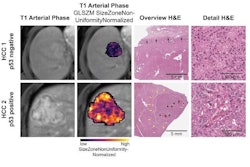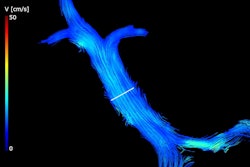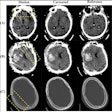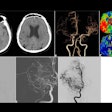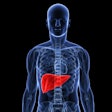Individually applying liver CT and MRI ancillary features to major imaging features does not change the diagnostic performance of the Liver Imaging Reporting and Data System (LI-RADS), suggest findings published July 8 in Radiology.
Researchers led by Nicole Abedrabbo from Duke University in Durham, NC, found no improvements in diagnostic performance when using ancillary features to upgrade LI-RADS 4 to LI-RADS 5 for diagnosing hepatocellular carcinoma (HCC).
“These findings suggest that there is redundancy in the added diagnostic value between major and ancillary features and that future versions of LI-RADS may be streamlined without impacting diagnostic performance,” Abedrabbo and co-authors wrote.
Ancillary features on liver CT or MRI may contribute to interreader variability since these features are applied at the radiologist’s discretion. The researchers noted that there is less data available on how ancillary features affect diagnostic performance.
A 2024 meta-analysis found that ancillary features showed independent links between most LI-RADS ancillary features and HCC, malignancy, and benignity. However, the authors pointed out that it remains unclear if these features have any significant impact on the diagnostic performance of LI-RADS.
Abedrabbo and colleagues used an individual participant data meta-analysis to study the impact of applying individual ancillary features on the diagnostic performance of CT and MRI LI-RADS.
Using various databases, the team included 46 studies published between 2014 and 2023 that evaluated the diagnostic accuracy of CT and MRI for HCC in at-risk adults. These studies used LI-RADS versions 2014, 2017, or 2018. The studies consisted of 9,257 observations, including 1,098 CT exams and 8,159 MRI exams, in 7,811 adults with an average age of 58.7 years.
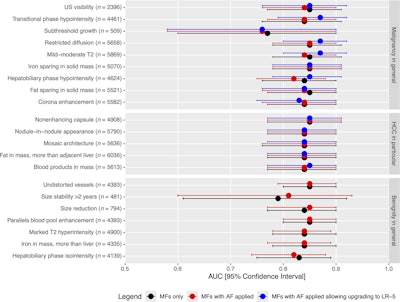 Forest plot of areas under the receiver operating characteristic curves (AUCs) and 95% confidence intervals obtained for LI-RADS categories 1 through 5 with (a) major features only (black), (b) major features with the application of each individual ancillary feature (red), and (c) major features with the application of each ancillary feature favoring malignancy in general and hepatocellular carcinoma (HCC), allowing for the upgrade of category LI-RADS 4 to category LI-RADS 5 (blue). Ancillary features are grouped by their intended association with malignancy in general, HCC in particular, or benignity in general, according to LI-RADS version 2018 (right axis).RSNA
Forest plot of areas under the receiver operating characteristic curves (AUCs) and 95% confidence intervals obtained for LI-RADS categories 1 through 5 with (a) major features only (black), (b) major features with the application of each individual ancillary feature (red), and (c) major features with the application of each ancillary feature favoring malignancy in general and hepatocellular carcinoma (HCC), allowing for the upgrade of category LI-RADS 4 to category LI-RADS 5 (blue). Ancillary features are grouped by their intended association with malignancy in general, HCC in particular, or benignity in general, according to LI-RADS version 2018 (right axis).RSNA
The team also employed three different strategies to measure performance: major features only, major features with each individual ancillary feature applied, and a strategy similar to the second strategy but allowing ancillary features favoring HCC or malignancy in general to upgrade category LI-RADS 4 to category LI-RADS 5.
The team observed no significant differences in area under the curve (AUC) values among all strategies for all ancillary features of all LI-RADS categories (p-value range, 0.65 to < 0.99). It also found no significant differences among all strategies in terms of positive predictive value (PPV), sensitivity, and specificity (p-value range, 0.11 to > 0.99).
And on sensitivity analysis of nine low-risk bias studies, the researchers observed no significant differences in AUCs for any of the ancillary features (p-value range, 0.63 to > 0.99). They also found no differences in PPV (p-value range, 0.29 to > 0.99), sensitivity (p-value range, 0.26 to > 0.99), or specificity (p-value range, 0.07 to > 0.99) for all ancillary features.
“Although ancillary features have shown strong independent associations with malignancy, HCC, and benignity, their individual impact on diagnostic performance appears negligible,” the study authors wrote.
The results may influence how ancillary features are implemented in the next LI-RADS update, according to an accompanying editorial by Adam Cory Searleman, MD, PhD, from the University of California, San Diego.
“Future iterations of LI-RADS should consider reducing or streamlining the use of ancillary features for risk categorization, but should still consider whether ancillary features can play a supportive role, such as the detection of LI-RADS observations,” Searleman wrote.
The full study can be read here.







